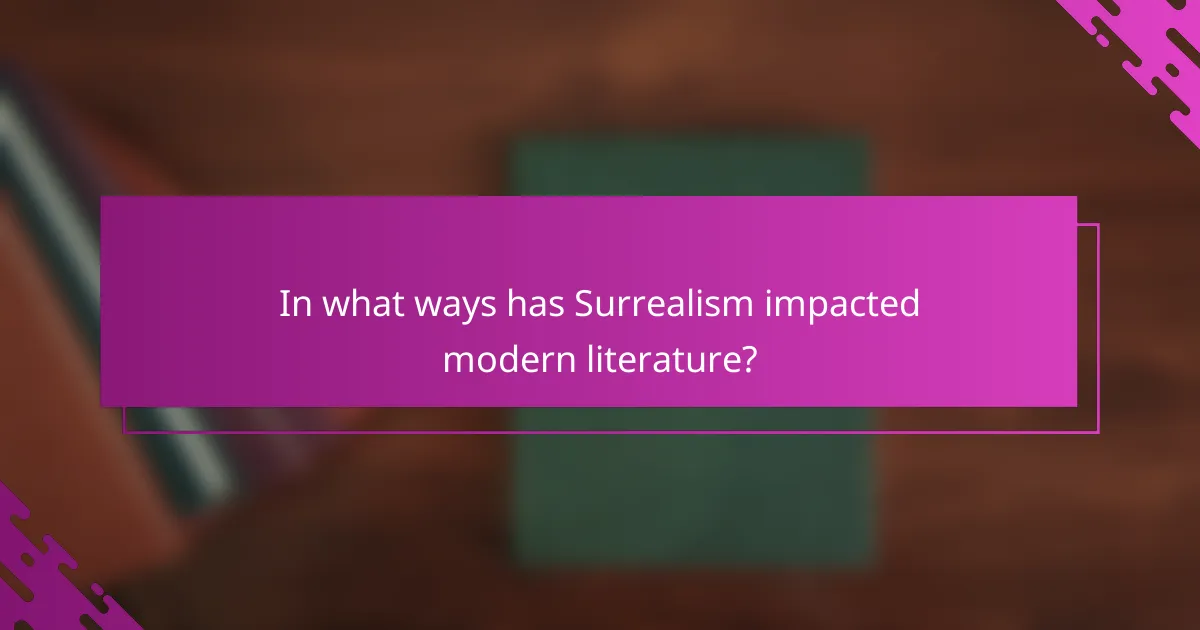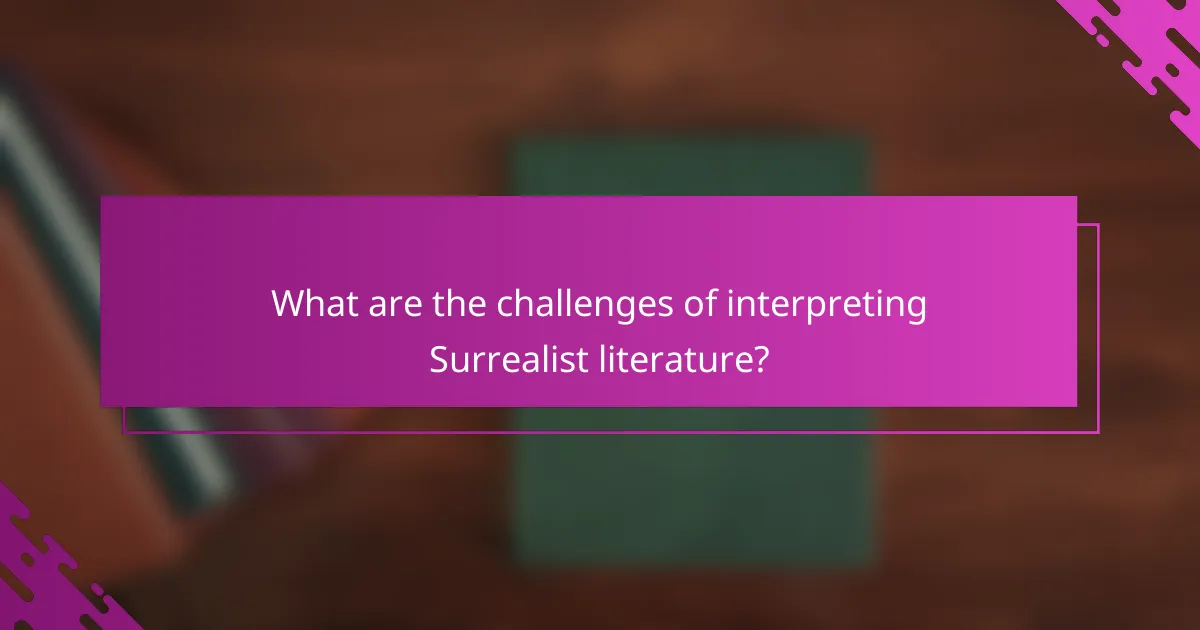Surrealism profoundly impacts modern literature by challenging traditional storytelling and exploring the unconscious mind. This article examines key techniques like dream imagery and unexpected juxtapositions. It highlights notable writers such as André Breton and Salvador Dalí, whose innovative approaches shaped the movement. Additionally, we explore the complexities of interpreting surrealist texts and provide guidance on incorporating these techniques in writing.

What techniques define Surrealist literature?
Surrealist literature is defined by techniques such as dream-like imagery, unexpected juxtapositions, and irrational narratives. These methods aim to challenge conventional perceptions of reality. Notable writers include André Breton and Salvador Dalí, who utilized these techniques to explore the unconscious mind. Surrealism’s role in modern literature lies in its influence on postmodernism and its ability to evoke emotional responses through unconventional storytelling.
How do automatic writing and free association contribute to Surrealism?
Automatic writing and free association are essential techniques in Surrealism, enabling spontaneous creativity. These methods allow writers to bypass rational thought, accessing the subconscious mind. Automatic writing involves producing text without conscious control, while free association encourages unfiltered expression of thoughts. Both techniques reveal hidden emotions and thoughts, fostering surreal imagery and unique narratives. Notable Surrealist writers, such as André Breton, utilized these methods to challenge traditional literary forms and explore the depths of human experience.
Which visual art influences shape Surrealist narrative styles?
Surrealist narrative styles are significantly shaped by visual art influences such as Dadaism, Cubism, and Expressionism. Dadaism’s anti-art sentiment encourages absurdity and spontaneity, echoing in Surrealist literature. Cubism’s fragmented perspectives inspire non-linear storytelling. Expressionism’s emotional intensity enhances the exploration of the subconscious. These art movements collectively inform Surrealism’s focus on dream-like imagery and irrationality, enriching its narrative techniques.
What role does dream imagery play in Surrealist texts?
Dream imagery is central to Surrealist texts, serving as a vehicle for exploring the unconscious mind. It allows writers to bypass rational thought, revealing deeper truths and emotions. This technique enhances the narrative’s emotional impact and challenges conventional perceptions of reality. Notable Surrealist writers, like André Breton, utilized dream imagery to convey complex psychological states, making it a unique attribute of the movement. Surrealism’s focus on dream imagery continues to influence modern literature, emphasizing the value of imagination in storytelling.

Who are the most notable Surrealist writers and their contributions?
Notable Surrealist writers include André Breton, Salvador Dalí, and Paul Éluard. Their contributions significantly shaped modern literature through innovative narrative techniques and exploration of the unconscious mind.
André Breton, known as the founder of Surrealism, emphasized automatic writing and the importance of dreams. Salvador Dalí introduced striking imagery and visual metaphors, enhancing the movement’s aesthetic appeal. Paul Éluard’s poetry often focused on love and freedom, intertwining personal experience with surrealist ideals.
Other influential figures include Louis Aragon, who experimented with narrative structure, and René Magritte, whose visual art inspired literary surrealism. Each writer’s unique approach contributed to a broader understanding of reality and imagination in literature.
How did André Breton influence the Surrealist movement?
André Breton significantly shaped the Surrealist movement through his writings and theories. He emphasized the importance of dreams and the unconscious, promoting automatic writing as a technique. Breton’s manifestos provided a framework for Surrealism, advocating for liberation from rational thought. His role as a leader fostered collaboration among artists and writers, creating a vibrant community that explored the boundaries of reality and imagination.
What unique perspectives did Virginia Woolf bring to Surrealism?
Virginia Woolf offered distinct insights to Surrealism, emphasizing psychological depth and stream-of-consciousness techniques. Her narratives explored the inner workings of the mind, challenging traditional narrative forms. Woolf’s unique perspective highlighted the fluidity of time and identity, merging personal experience with broader existential themes. This approach enriched Surrealism, fostering a deeper understanding of human consciousness and emotional complexity.
Which contemporary authors are inspired by Surrealist principles?
Contemporary authors inspired by Surrealist principles include Haruki Murakami, Salman Rushdie, and David Lynch. These writers incorporate dream-like narratives and explore the subconscious, reflecting the core techniques of Surrealism. Murakami’s works often blend reality with fantastical elements, while Rushdie employs magical realism. Lynch’s storytelling in film evokes surreal imagery, showcasing the lasting impact of Surrealism on modern literature.

In what ways has Surrealism impacted modern literature?
Surrealism has profoundly influenced modern literature by introducing innovative techniques and themes. It emphasizes the subconscious, dream-like imagery, and unexpected juxtapositions, which have shaped contemporary narrative styles. Notable writers like André Breton and Salvador Dalí have pioneered these methods, encouraging others to explore the boundaries of reality in their works. As a result, modern literature often reflects surrealist principles, challenging traditional storytelling and inviting deeper psychological exploration.
How does Surrealism challenge traditional narrative structures?
Surrealism challenges traditional narrative structures by employing dreamlike imagery and illogical scenes. This technique disrupts linear storytelling, creating a sense of disorientation. Notable writers like André Breton and Salvador Dalí used these methods to explore the subconscious. As a result, Surrealism redefined narrative possibilities in modern literature, emphasizing emotion over coherence.
What cultural movements parallel Surrealism’s evolution in literature?
Cultural movements that parallel Surrealism’s evolution in literature include Dadaism, Expressionism, and Futurism. Dadaism, emerging during World War I, challenged traditional aesthetics and embraced chaos, influencing Surrealist techniques. Expressionism focused on emotional experience over realism, impacting narrative styles in Surrealist works. Futurism celebrated modernity and technology, contributing to the avant-garde spirit of Surrealism. Each movement shared a rejection of conventional norms, fostering creativity and innovation in literature.
Which themes from Surrealism resonate in today’s literary works?
Surrealism’s themes continue to influence modern literature through dream-like narratives, absurdity, and exploration of the unconscious. Writers like Haruki Murakami and Neil Gaiman incorporate surreal elements, blurring reality and imagination. The unique attribute of surrealism lies in its ability to challenge conventional logic, inviting readers to experience deeper psychological truths. As a result, contemporary works often reflect surrealism’s legacy, fostering creativity and innovative storytelling.

What are the challenges of interpreting Surrealist literature?
Interpreting Surrealist literature presents challenges due to its inherent complexity and abstract nature. The non-linear narratives often defy conventional logic, making comprehension difficult. Symbolism plays a crucial role, requiring readers to decode meaning beyond the text. Additionally, the emotional intensity and dream-like imagery can lead to varied interpretations, complicating consensus among readers. Understanding the historical and cultural context of Surrealism further adds layers to interpretation, as it influences the themes and techniques employed by writers.
How do cultural contexts influence the understanding of Surrealist texts?
Cultural contexts significantly shape the interpretation of Surrealist texts by influencing themes and symbols. Different cultures bring unique perspectives, altering the understanding of dreamlike imagery and irrationality. For example, Western audiences may focus on individual subconscious, while Eastern interpretations might emphasize collective consciousness. This diversity enriches Surrealism, allowing for varied emotional and intellectual responses. The unique attribute of Surrealism lies in its ability to transcend cultural boundaries, inviting diverse interpretations that reflect individual and collective experiences.
What common misconceptions exist about Surrealism?
Many misconceptions about Surrealism include the belief that it solely focuses on dreams or irrationality. In reality, Surrealism employs techniques like automatic writing and juxtaposition to challenge perceptions. Another common myth is that it lacks structure; however, many works demonstrate meticulous composition. Some also think Surrealism is outdated, yet its influence persists in contemporary literature and art.

How can writers effectively incorporate Surrealist techniques?
Writers can effectively incorporate Surrealist techniques by embracing dream imagery, unexpected juxtapositions, and free association. These methods stimulate the subconscious, allowing for innovative narratives. Notable writers like André Breton and Salvador Dalí exemplify these techniques, merging reality with the fantastical. Utilizing automatic writing can also enhance creativity, breaking conventional thought patterns.
What best practices should authors follow when experimenting with Surrealism?
Authors experimenting with Surrealism should embrace spontaneity, dream imagery, and unconventional narratives. First, practice free association to unlock subconscious thoughts. Second, study works by notable surrealists like André Breton and Salvador Dalí for inspiration. Third, incorporate unexpected juxtapositions to challenge readers’ perceptions. Lastly, allow the text to evolve organically, avoiding strict plot structures. This approach enhances creativity and aligns with Surrealism’s core principles.
Which common mistakes should be avoided in Surrealist writing?
Common mistakes in Surrealist writing include lack of coherence, over-explanation, and neglecting emotional impact. Writers often fail to embrace ambiguity, which is essential in Surrealism. Another mistake is forcing symbolism, rather than allowing it to emerge naturally. Additionally, ignoring the subconscious elements can weaken the surreal quality of the work.



